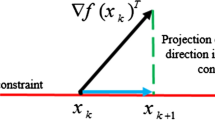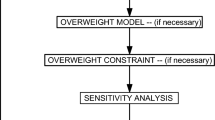Abstract
This research applies topology optimization to create feasible functionally graded compliant mechanism designs with the aim of improving structural performance compared to traditional homogeneous compliant mechanism designs. Converged functionally graded designs will also be compared with two-material compliant mechanism designs. Structural performance is assessed with respect to mechanical/geometric advantage and stress distributions. Two design problems are presented – a gripper and a mechanical inverter. A novel modified solid isotropic material with penalization (SIMP) method is introduced for representing local element material properties in functionally graded structures. The method of moving asymptotes (MMA) is used in conjunction with adjoint sensitivity analysis to find the optimal distribution of material properties. Geometric non-linear analysis is used to solve the mechanics problem based on the Neo-Hookean model for hyperelastic materials. Functionally graded materials (FGMs) have material properties that vary based on spatial position. Here, FGMs are implemented using two different resource constraints – one on the mechanism’s volume and the other on the integral of the Young’s modulus distribution throughout the design domain. Tensile tests are performed to obtain the material properties used in the analysis. Results suggest that FGMs can achieve the desired improvements in mechanical/geometric advantage when compared to both homogeneous and two-material mechanisms.











Similar content being viewed by others
References
Alonso C (2014) Topology synthesis of multi-material compliant mechanisms with Sequential Element Rejection and Admission. Finite Elem Anal Des 85:11–19
Alonso C, Querin OM, Ansola R (2013) A sequential element rejection and admission (SERA) method for compliant mechanisms design. Springer, Berlin
ASTM (2014) D638-14 Standard test method for tensile properties of plastics, ASTM International
Basar Y, Weichert D (2000) Nonlinear continuum mechanics of solids: fundamental mathematical and physical concepts. Springer, Berlin Heidelberg
Batoz JL, Dhatt G (1979) Incremental displacement algorithms for nonlinear problems. Int J Numer Methods Eng 14(8):1262–1267
Belytschko T, Liu WK, Moran B, Elkhodary K (2002) Nonlinear Finite elements for continua and structures. Wiley, Chichester
Bendsøe M P (1989) Optimal shape design as a material distribution problem. Struct Optim 1(4):193–202
Bendsoe MP, Sigmund O (1999) Material interpolation schemes in topology optimization. Arch Appl Math 69:635–654
Bruns TE, Totorelli DA (2001) Topology optimization of non-linear structures and compliant mechanisms. Comput Methods Appl Mech Eng 190(26-27):3443–3459
Buck J, Mc Mahon T, Huot D (2014) Space station 3-D printer builds ratchet wrench to complete first phase of operations. [Online]. Available: https://www.nasa.gov/mission_pages/station/research/news/3Dratchet_wrench. [Accessed 12/12/2016]
Carbonari RC, Silva ECN, Paulino GH (2009) Multi-actuated functionally graded piezoelectric micro-tools design: a multiphysics topology optimization approach. Int J Numer Methods Eng 77(3):301–336
Carbonari RC, Paulino GH, Silva ECN (2010) Integral piezoactuator with optimum placement of functionally graded material - a topology optimization paradigm. J Intell Mater Syst Struct 21(16):1653–1668
Gaynor A, Meisel NA, Williams CB, Guest JK (2014) Multiple-material topology optimization of compliant mechanisms created via polyjet three-dimensional printing. J Manuf Sci Eng 136(6)
Gea HC, Luo J (2001) Topology optimization of structures with geometrical nonlinearities. Comput Struct 79(20-21):1977–1985
Gomes FA, Senne TA (2014) An algorithm for the topology optimization of geometically nonlinear structures. Int J Numer Methods Eng
Holzapfel GA (2000) Nonlinear solid mechanics: a continuum approach for engineering science. New York, Wiley
James KA, Waisman H (2016) Layout design of a bi-stable cardiovascular stent using topology optimization. Comput Methods Appl Mech Eng 305:869–890
Karush W (1939) Minima of functions of several variables with inequalities as side constraints, Master’s Thesis. University of Chicago, Chicago
Kim NH (2015) Introduction To nonlinear finite element analysis. Springer US, New York
Kuhn H, Tucker A (1951) Nonlinear Programming. In: Proceedings of 2nd Berkeley Symposium, Berkeley, CA
Lou Y, Li M, Kang Z (2016) Topology optimization of hyperelastic structures with frictionless contact supports. Int J Solids Struct 81:373–382
Marckmann G, Verron E (2006) Comparison of hyperelastic models for Rubber-Like materials. Rubber Chem Technol 79(5):835–858
Marin A, Fuentes AA (2016) Human bone: functionally graded material structures with complex geometry and loading, Department of Mechanical Engineering, University of Texas-Pan American
Miyamoto Y, Kaysser WA, Rabin BH, Kawasaki A, Ford RG (1999) Functionally graded materials: design processing and applications, Springer
OpenStax (2013) Anatomy & Physiology. OpenStax
Pedersen CBW, Buhl T, Sigmund O (2001) Topology synthesis of large-displacement compliant mechanisms. Numer Meth Eng 50(12):2683–2705
Prater TJ, Bean QA, Beshears RD, Rolin TD, Werkheiser NJ, Ordonez EA, Ryan RM, Ledbetter III FE (2016) Summary report on phase I results from the 3D printing in zero g technology demonstration mission, volume I, NASA technical reports server
Ramos Jr. AS, Paulino GH (2015) Convex topology optimization for hyperelastic trusses based on the ground-structure approach. Struct Multidiscip Optim 51(2):287–304
Sigmund O (1997) On the design of compliant mechanisms using topology optimization. Mech Struct Mach Int J 25(4):493–542
Sigmund O (2001) Design of multiphysics actuators using topology optimization – Part II: Two-material structures. Comput Meth Appl Mech 190(49-50):6605–6627
Sigmund O, Torquato S (1997) Design of materials with extreme thermal expansion using a three-phase topology optimization method. J Mech Phys Solids 45(6):1037–1067
Sigmund O, Petersson J (1998) Numerical Instabilities in topology optimization a survey on procedures dealing with checkerboards, Mesh dependencies and local minima, Structural Optimization, Springer
Sigmund O, Torquato S (1999) Design of smart composite materials using topology optimization. Smart Mater Struct 8(3):365–379
Stegmann J, Lund E (2005) Discrete material optimization of general shell structures. Int J Numer Methods Eng 62(14):2009–2027
Stump FV, Silva ECN, Paulino GH (2007) Optimization of material distribution in functionally graded structures with stress constraints. Commun Numer Methods Eng 23(6):535–551
Svanberg K (1987) The method of moving asymptotes a new method for structural optimization. Int J Numer Methods Eng 24(2):359–373
Udupa G, Rao SS, Gangadharan KV (2014) Functionally graded composite materials: an overview. In: Procedia Materials Science, vol 5. Elsevier, pp 1291–1299
Wolf D, Yip S (1993) Material interfaces: atomic-level structure and properties, Springer, Netherlands
Wriggers P (2008) Nonlinear finite element methods. Springer, Berlin Heidelberg
Xia Q, Wang M (2008) Simultaneous optimization of the material properties and the topology of functionally graded structures. Comput Aided Des ACM Symp Solid Phys Model Appl 40(6): 660–675
Yin L, Ananthasuresh GK (2002) A novel topology design scheme for the multi-physics problems of electro-thermally actuated compliant micromechanisms. Sensors Actuators A Phys 97-98:599–609
Yin L, Ananthasuresh GK (2003) Topology optimization of compliant mechanisms with multiple materials using a peak function material interpolation scheme. Struct Multidiscip Optim 23(1):49–62
Zhou M, Rozvany GIN (1991) The COG algorithm, Part II: topological, geometrical and generalized shape optimization. Comput Methods Appl Mech Eng 89(1-3):309–336
Author information
Authors and Affiliations
Corresponding author
Rights and permissions
About this article
Cite this article
Conlan-Smith, C., Bhattacharyya, A. & James, K.A. Optimal design of compliant mechanisms using functionally graded materials. Struct Multidisc Optim 57, 197–212 (2018). https://doi.org/10.1007/s00158-017-1744-y
Received:
Revised:
Accepted:
Published:
Issue Date:
DOI: https://doi.org/10.1007/s00158-017-1744-y




